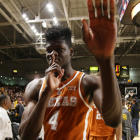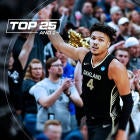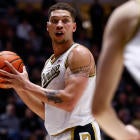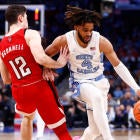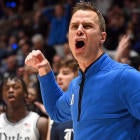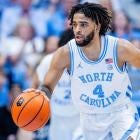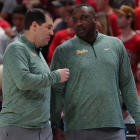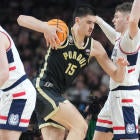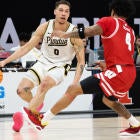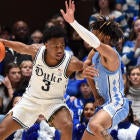The annual NBA Draft Combine provides fans, scouts and NBA decision-makers a look at some of the top prospects in the NBA Draft in an environment that will test their mental and physical abilities. Players will be measured, drilled, ran and asked to compete against other players in addition to interviews and the ever-important medical evaluations.
So while current NBA players participate in the final weeks of the playoffs, NBA hopefuls will do their best to improve their stock and impress attendees on and off the floor in Chicago before the Combine concludes on Sunday.
Here are some key questions surrounding the event.
Who participates in what?
A general question, but always a big one. The NBA combine has myriad individual athletic tests, including two kinds of vertical leap (standing and max), a three-quarter-court sprint, bench press, lane agility, shuttle run and a variety of shooting drills. It also holds five-on-five scrimmages, which seldom include participation from projected lottery picks.
In this regard, the combine loses a lot of its luster when top 20-type prospects opt out of some, if not all (Deandre Ayton, for example, isn't even going to be at the combine) aspects of the event.
We'll soon have a better idea of who thinks they stand where, based in good part on how much they do at the combine. I always love when a highly touted player opts to play five-on-five and in general does everything asked of him at the combine.
How will Donte DiVincenzo and Omari Spellman do?
Villanova's hopes of winning a third national title in four years probably rest with at least one of these two players returning to school. I doubt both will. For Spellman, a big man with range and someone with only one year of college experience (he was a redshirt freshman), he has a really good opportunity to stand out this week.
DiVincenzo has a fascinating situation in front of him. Because of his Most Outstanding Player performance at the Final Four, his stock and Q Score skyrocketed. So if he opted to return to school, he'd not only be the most well known player in college basketball -- he would also be a likely first-team All-America selection in the preseason. He could put up huge numbers at Villanova and potentially boost his stock even more for 2019.
But he also might not do that, which means it could be time to take advantage right now. It would not shock me if DiVincenzo has a strong combine and opts to keep his name in the draft.
Will Trae Young impress?
This is likely to happen for at least one reason: Young's yoking up. I spoke with his father earlier this week, and he told me Trae's put on at least 10 pounds of muscle since he publicly declared for the draft. Young has been working out in California, and clearly the updating of his frame has been a primary focus for him in the lead-up to the draft. Why? Because Young's size has been a primary point of critique in terms of his NBA forecast.
Aside from that, Young will be tracked intensely at the combine because he falls in that 4-10 range of prospects. If he has a poor combine, how much will it impact him in that No. 4, 5 or 6 range? If he shows up, competes in most events and tests well, buzz around him will only grow.
He's the most famous prospect in this draft. But for the past seven weeks -- for the first time since early November, right before his name blew up, Young has been off the radar and out of public discussion. Expect a lot of coverage around Young over the next month.
Who has the most to lose?
Honestly? From what I gather, this notion is something of a myth. Generally speaking, the NBA combine is an opportunity, not a gambling proposition. Players can help their situation, but it's hard to really hurt your standing in your projected range unless you completely bomb the interview process or test so badly vs. the rest of the draft pool.
So if a player is considered in the 40-50 range by most evaluators, for example, they're probably still going to be drafted regardless of what happens at the combine. The upside of the combine is that player doing enough to entice a few teams to potentially move that player from, say, 42 on their board to 34 or 35.
How will mystery men Brian Bowen and Billy Preston look?
Here are two five-star prospects from the high school Class of 2017 who never played college basketball. Bowen was part of the Louisville fiasco in the FBI investigation. Preston had a mysterious situation with a car at Kansas, then eventually bailed on school after his eligibility couldn't be cleared in time for his liking.
So now we get a look at both of these players at the combine. Preston is a power forward who will probably test well and have good measurements. Bowen is a fascinating inclusion. He's currently enrolled at South Carolina, but his college eligibility is up in the air.
Meantime, Bowen's lawyer has taken to Twitter to publicly lobby for the NCAA to resolve his case.
Please RETWEET: The NCAA must make a ruling on Brian Bowen’s eligibility before the May 30 deadline to withdraw from NBA draft pool. Regardless of how you feel about Brian’s case, can we agree that win or lose he deserves due process after almost a year in limbo. #ncaa #sportslaw
— Jason Setchen (@AthleteDefender) May 17, 2018
See, Bowen wasn't considered a one-and-done talent prior to going to college. It can't hurt for him to try the process out, but he's stuck in a weird situation because he could get feedback that he's not a likely draft pick ... yet he doesn't know if he's ever going to be cleared to play at South Carolina. There won't be one player in Chicago who envies Bowen's position.
Will any inappropriate or bizarre questions be asked?
This is one thing the NFL and NBA combines share in common. The philosophy behind asking such questions is, frankly, weird. Are these questions, and the answers that come, bringing any more clarity to a player and his fit in a given organization? Last year, Frank Mason revealed he was asked by one team how he would like to die.
Not OK!
Other questions over the years have purportedly included:
- How many basketballs can fit in this room?
- Why is a manhole cover round?
- What's your alcoholic drink of choice?
- What's your favorite strain of marijuana?
- Can you explain each tattoo you have?
Who will test best athletically?
It's not critical, but it is fun to see who's best. Remember, dominating the athletic and agility tests doesn't ensure anything. Last year, Hamidou Diallo was considered one of the top performers at the combine. Yet for as strong as his testing was, that wasn't enough to push him into territory where he thought being picked at a relatively high number was a guarantee. Because of that, he returned to Kentucky.
Still, every year at the combine there are prospects that wind up performing well in the vertical leaps and speed tests, putting up numbers that certainly help their reputation. Who will it be this year? Who jumps highest? The NBA is an athletic endeavor above all, so proving your athletic prowess at the combine is helpful, and in reality, probably keeps a few doors open in the ensuing month.
Can Michael Porter Jr. jump into the top-four conversation?
There are a couple of things I find interesting at this stage of the pre-draft process. The first is that, after Marvin Bagley III was discussed as, at the very least, an equal to Ayton for much of the past three years, he's suddenly/seemingly a distant third behind Ayton and Luka Doncic. I'm not buying that just yet.
The other is that Michael Porter Jr. was once discussed as a future No. 1 pick. Then the back surgery came early last season, and now he's no longer in that conversation. It's understandable. But if Porter Jr. dose well at the combine, can he overcome some of the knocks against him? (There are some concerns beyond the back issues.) If he does, might we see a "top four" separation of prospects instead of the current top three of Ayton/Doncic/Bagley?
How much of it will matter?
This is what I keep coming back to. The combine's value is up for debate. I've spoken to people over the years who think much of it is a waste of time. After all, almost all of these players will wind up doing private workouts for teams in the ensuing weeks anyway. The five-on-five stuff isn't as competitive as it should be, and yet it can't be, because it's controlled by design. Athletic testing gets you some interesting numbers, but how much do those results correlate to on-court success for years to come in the NBA?
For some scouts, though, the combine presents the only opportunity to see most prospects in one space at one time and evaluate the players off each other. It is a fair shot to take in everyone and see who stands out among the crowd. So that brings us back to the big question: Who is going to stand out most? We're about to find out. And then, on June 21, we'll find out if it even mattered.












